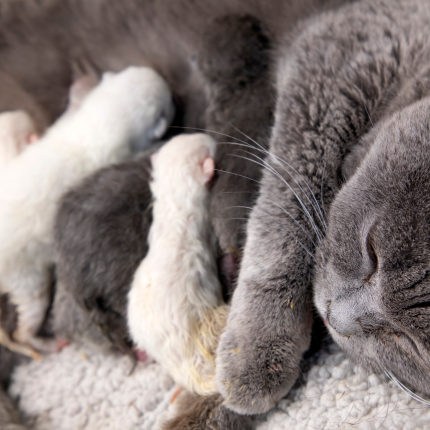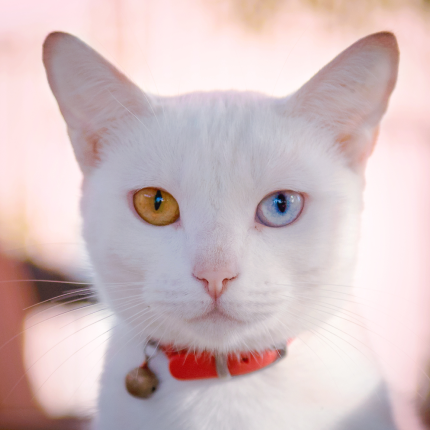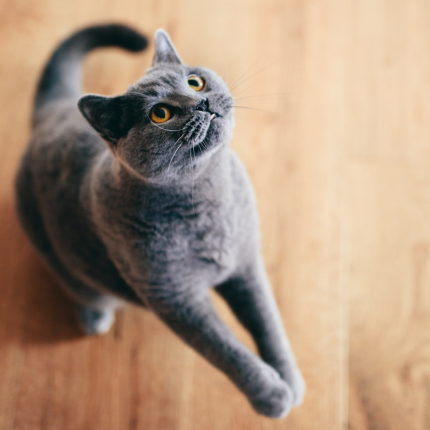Cat Mating, Reproduction, and Care

The intricacies of cat mating and reproduction may be more complex than they initially appear. While it may seem that cats mate frequently and indiscriminately, leading to the birth of adorable kittens, the reality is more nuanced. Did you know that cats only ovulate when they mate? Or that a female cat can give birth to a litter of kittens, each from a different father, a phenomenon called superfecundation? That’s a lot of weird facts! Maybe there’s more to learn about cat mating and reproduction complexities.
A Cat in Heat
Recognizing the signs of a cat in heat is crucial for cat owners, as female cats not spayed will eventually go through estrus. Although it may sound strange to humans, who take many years to reach reproductive maturity, a kitten can experience her first heat at four months old. Once a female cat has her first heat, she will experience heat cycles until she mates or is spayed. Behavioral symptoms, such as increased vocalization and restlessness, can indicate that a cat is in heat and actively seeking a male companion.
If a female cat in heat has access to an un-neutered male cat (tom), the likelihood of pregnancy is high. Identifying the physical and personality changes associated with pregnancy becomes important approximately three weeks after mating. Deciding whether to allow the pregnancy to continue or opt for spaying is a significant decision that should involve discussions with your family and veterinarian.
Cat Pregnancy
Providing appropriate care for a pregnant cat is essential for her health and the well-being of the unborn kittens. Important considerations include creating a comfortable environment, ensuring proper nutrition through quality and quantity of food, and minimizing stress.
Pregnant cats can encounter complications such as premature labor, metabolic changes (including gestational diabetes), fatty liver, or eclampsia (low calcium levels). While most pregnant cats undergo gestation without significant trouble, it’s essential to closely monitor them and promptly notify your veterinarian of any concerning signs or behaviors.
It’s Game Time!
When the time comes for the birth process, most cats can handle it naturally without human intervention. However, it is crucial to understand potential complications and know when to seek assistance. The postnatal period requires attentive care, particularly during the first few weeks. Creating a warm and peaceful space for the mother and kittens, allowing them to bond and nurse, is crucial for their well-being.
Eventually, the time will come to find suitable homes for the kittens. Ensuring responsible adoptions by conducting thorough screenings and providing necessary vaccinations and health treatments is crucial. Finally, it is imperative to prioritize the spaying of the mother cat, as responsible pet ownership requires taking steps to prevent future pregnancies.
By understanding the various stages of cat mating, reproduction, and the care required during pregnancy and beyond, cat owners can provide the best possible care for their feline companions. Responsible cat ownership involves comprehensive knowledge and proactive decision-making, from recognizing heat cycles to navigating the birthing process and finding loving homes for the kittens.

Featured Articles

Why Do Cats Roll Over Into Their Backs But Not Let You Touch Their Bellies?
It’s common knowledge dogs love to have their tummies rubbed when they freely lay down before you and roll onto their backs. But, if you’re also familiar with cats, you know that when they roll onto their backs with their bellies exposed, rubbing the belly will most likely result in…

Polydactyl Cats: Just More Beans to Love
Polydactyl cats have become extremely popular in recent times. As a result, more and more people are interested in learning more about this six-toed cat and want to get one of their own. If you are a cat lover intrigued by polydactyl cats, you have come to the right place….

The Odd-Eyed Cat (AKA Heterochromia)
Cats are already beautiful and fascinating creatures, but people are bound to take notice when they have something as captivating as two different colored eyes. Odd-eyed cats always have one blue eye paired with either a green, yellow, or brown eye. This form of heterochromia occurs in other animals, including…
